600 Dollar Sneacker That Look Like Socks
Just like with suits, there's a huge difference between inexpensive and the more expensive shoe. In this guide, we will help you to identify what's quality and what isn't so you get the best value for your money no matter if your budget is $100, $200 – $400 or $500+.
Price Is Not A Good Indicator of Shoe Quality
Unfortunately, the price isn't always a good indicator of shoe quality.For example, designers such as Gucci, Armani, Tom Ford and others automatically charge more because they have a name, no matter what the construction of quality of the shoe. Moreover, even lower-end or not well-known brands often have hugely different prices for the same quality of shoes.
Even among inexpensive shoes, the qualities can differ.
Sometimes, people just don't wear dress shoes very often, so they don't want to invest a huge amount of money. Other people have the money, but they don't want to spend it, or they simply don't know the difference, and they look at them, and they think they're all the same.
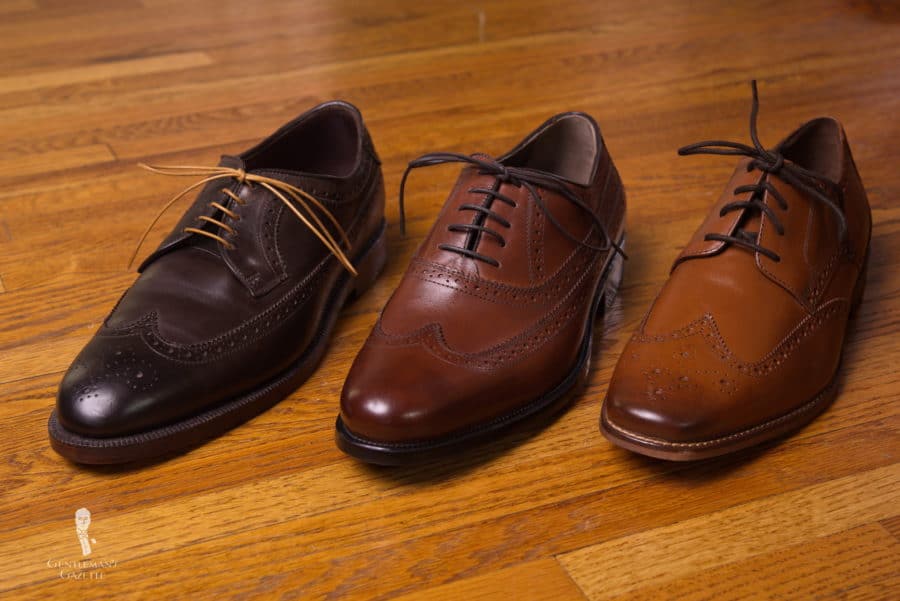
$500 Allen Edmonds vs. $100 Johnston Murphy vs. Florsheim
Shoe Features & Quality Hallmarks
The only way for you to truly understand what you are getting when you buy a pair of shoes is to educate yourself before you buy. Therefore we outline quality hallmarks in different price ranges.
$100 Shoes
- Faux Stitching. Most dress shoes in this price range feature something that looks like a welt or stitching but more often than not, it's simply glued, and the stitching is merely decorative, so it looks like a more expensive shoe. Even though there are glues in the market today that keep houses together, what's generally used for shoes is less expensive, cheaper, and doesn't glue as well. Therefore, soles will likely come off after a year or two of hard wear, and then you can glue them back on, but most of the time, the shoe is in such bad condition overall that it must be thrown away.
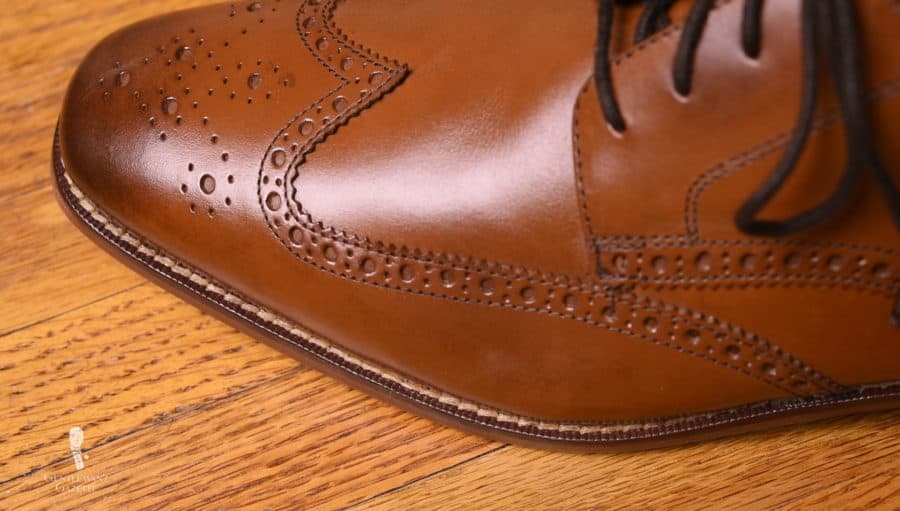
Florsheim faux stitching
- Soles. Sometimes you can see a welt at the bottom but don't be fooled. That is probably just a Blake stitch or maybe a Blake Rapid stitch but generally not a Goodyear welt. If you look closely, it looks like leather at first sight, but in fact, it's just a composite material that is supposed to look like leather but it's cheaper, and it's actually rubber. Most of the time, men's dress shoes in this price range have either composite material that's meant to look like leather, or you have a rubber sole. Even if you get leather, it will be of a lower quality that wears much more quickly than on a more expensive shoe.
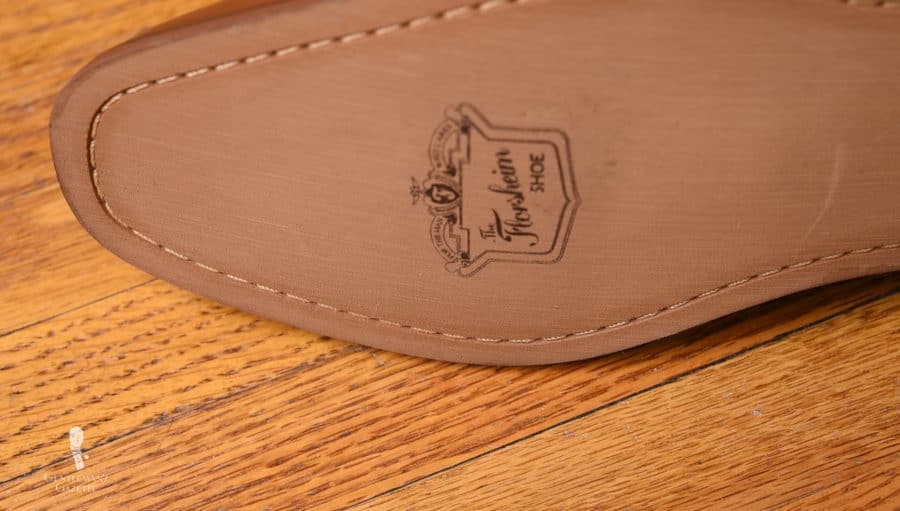
Composite material that looks like leather at first sight
- Details. Something that you find a lot in $100 shoes is that they try to fake higher end details but usually, the execution is not quite as refined. For example, on this Johnston & Murphy shoe, you have a stitched pattern at the bottom, and you can see a stitched pattern at the top, however, at the top, it's just injection molded so it's not a real stitch and it's simply meant to be deceitful.
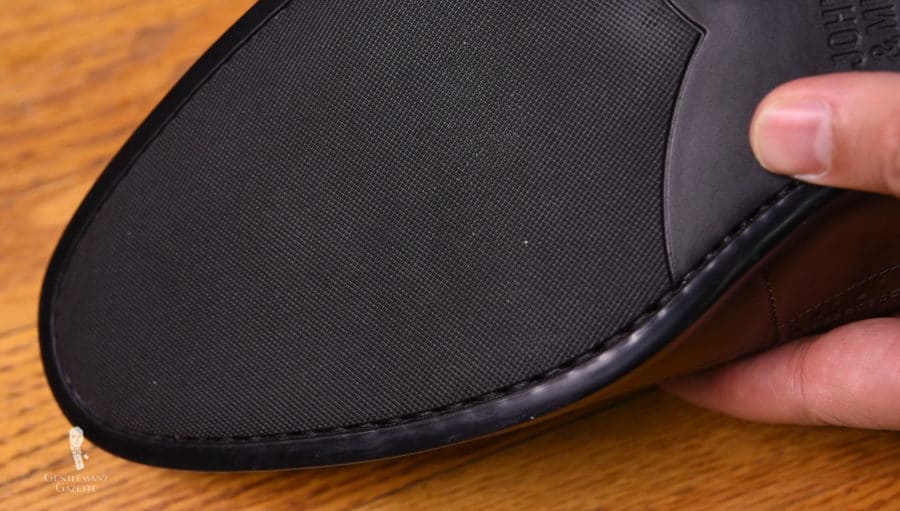
Johnston Murphy rubber sole with stitching
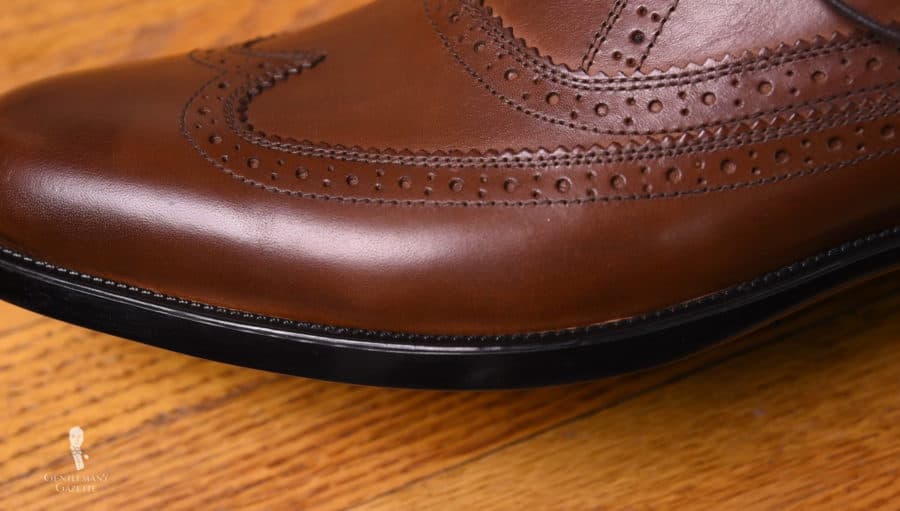
Johnston Murphy injection molded welt pattern
- Inferior leather quality. Usually, the leather is quite hard and to sell the shoe for a $100 retail, the leather must be cheap. That means second or third-grade leather that is then sanded and pigmented with dye to cover up all the flaws. Even though it may not look very different than a high-quality leather when new, once you walk in it, you create creases, and the pigmented leather will just age very poorly. The pigments will come off and expose what's underneath. Also, the leather won't develop a nice patina; it just looks cheap, and the shoe looks worse the longer you wear it.
- More Leather pieces. Shoes in this price range often have many leather pieces sewn together because the labor costs in Asia are low and using smaller pieces allows getting more yield from the leather. Just like in the example below, that can lead to multiple uneven seams and broguing that is not classic and simply too much.
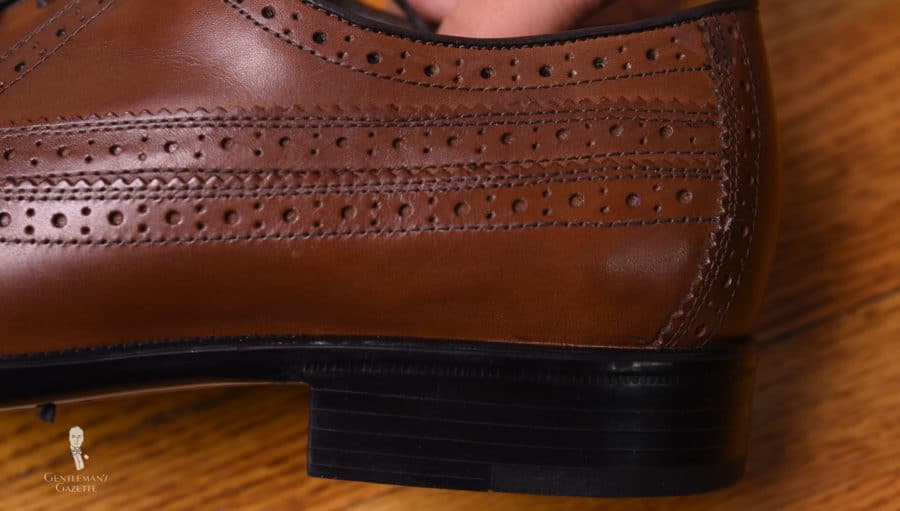
Unusual styling with three rows of broguing right next to each other
- Unrefined lasts. In this price range, the shoe shape and lasts are generally chunky, with a large or boxy toe, and overall wide, clunky look so they fit every kind of foot. Usually, the last is one of those things in a shoe that quickly reveals the quality of a shoe because personally, we have never seen an inexpensive men's dress shoe with a refined last.
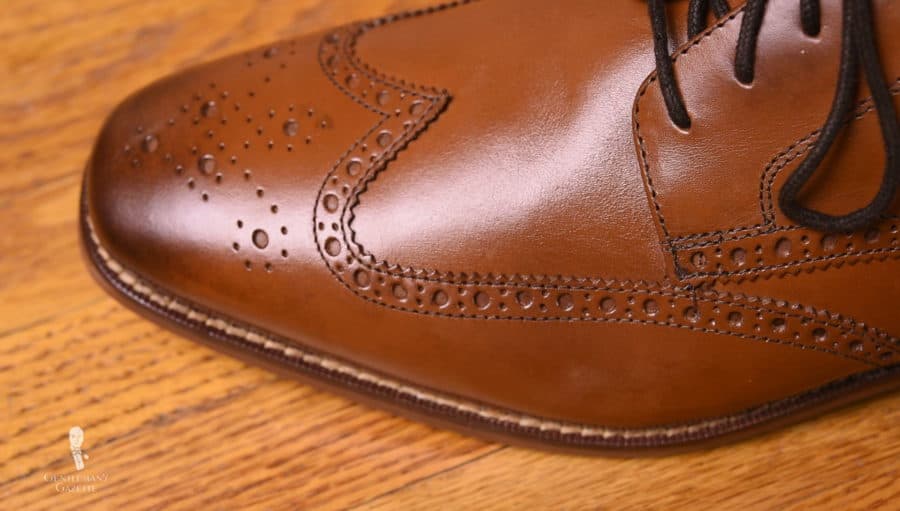
Florsheim pigment dyed stiff upper leather
- Padded Interior. Usually, the leathers are so stiff and hard that manufacturers have to put padded foam on the inside of the shoes to make them comfortable to walk in. So when you put on the shoe for the first time, it feels quite soft, cushiony, and comfortable. However, it's cheap foam that will wear out very quickly, and once it does, you just have a hard, uncomfortable leather left.
- Limited Colors. Apart from that, you usually don't have much color choice. You get black, brown, or tan, but you probably won't find a nice burgundy shoe or a beautiful hand patina finish that gets better with age.
Conclusion $100 Men's Dress Shoe
Basically, a $100 shoe is made of inferior materials, and will only last for a year, or maybe two before it must be thrown away.
$200-$400 Shoes
The next step up in shoes provides a wide range of materials used and construction techniques implemented. While some shoes in this price range provide immense value, other are overprices. Therefore it is particularly important to take a closer look at these shoes. In the $200-$400 section, you'll find the Blake or Blake Rapid construction most of the time:
- Blake construction. Men's dress shoes in this price range are generally sewn and not glued. The most prevalent shoe construction method in this price range is Blake or Blake Rapid. Compared to a Goodyear welt, a Blake constructed shoe has a thinner and softer sole. Therefore it is most often used for summer shoes such as loafers that are supposed to be light. The disadvantage of Blake is that it lacks the cork filling, which makes the shoe less comfortable to stand and walk in, especially on a long day. Moreover, your feet are more likely to get wet from the bottom, when it is raining a lot. Blake stitching is very popular in Italy. So if your shoes are made there, it's likely Blake. You can identify a Blake constructed show by the stitching on the inside sole of the shoe. Last but not least, Blake shoes are not easily repairable.
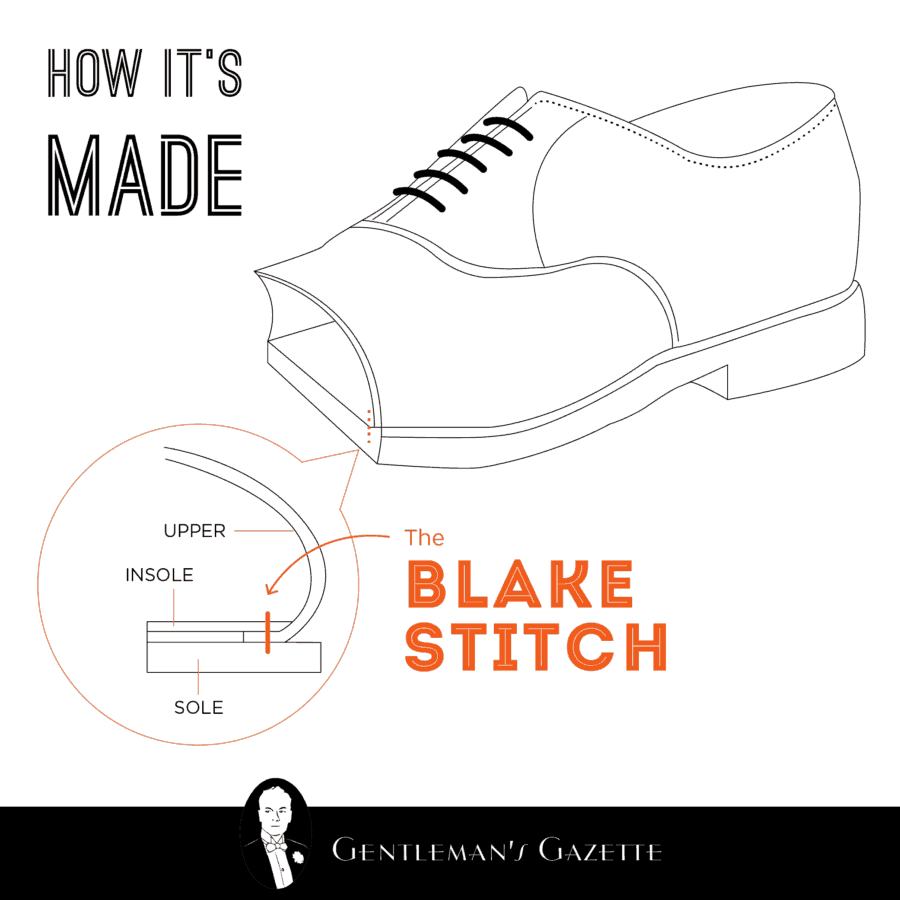
Blake Construction
- Blake Rapid construction.A more rarely used method in this price range, Blake Rapid is basically the same as Blake Construction with an additional leather sole attached to the bottom. It helps to keep your feet dry, and will add a little bit more comfort, but overall, it is not as comfortable as Goodyear welted shoes, while both can be repaired fairly easily.
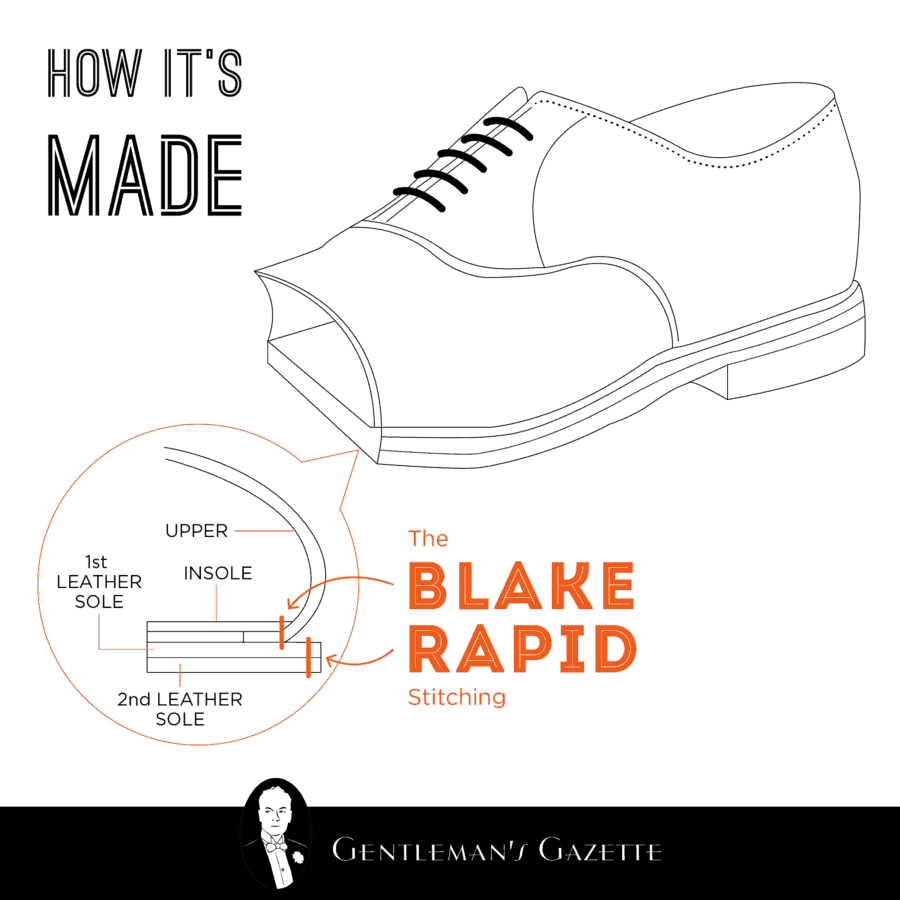
Blake Rapid Construction
- Leather. Leathers in this price range can be very high-grade or just medium-grade, or even low-grade sometimes.
What Should You Buy?
This price range can be very tricky. For example, if you take a Jay Butler loafer, it's a Blake construction, it's a nice leather, it's made in Mexico, and it's about a $200 shoe. In my opinion, it's great value for the money.
On the other hand, if you look at Paul Evans, they have the same Blake construction, shoes are made in Italy, the patina is very nice. However, the lasts are quite unrefined, and they charge $400 for the shoes. For $250 it would be a fair deal, but for $400, they're totally overpriced.
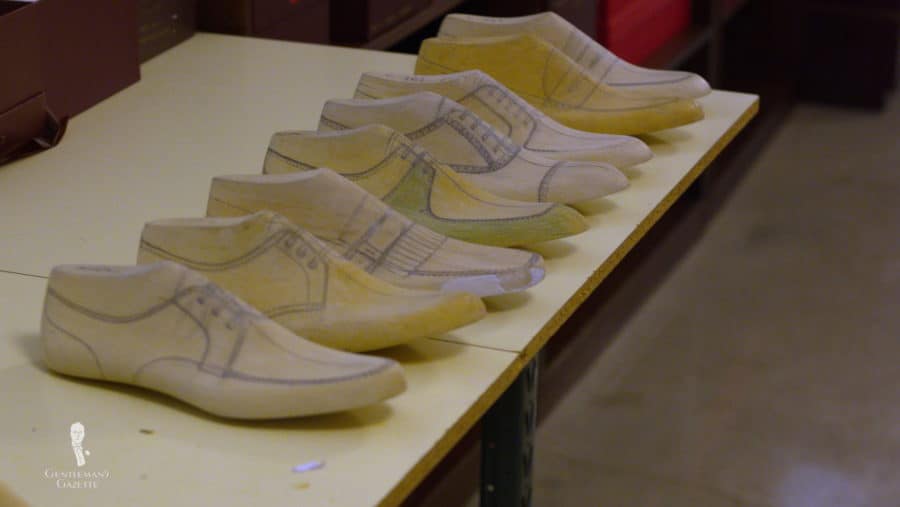
Refined lasts
Especially, if you compare them to a shoe like Cobbler Union which costs the same, is Goodyear welted, has an actual channel stitch at the bottom, has quality leather, has a good leather interior, it's quilted, and the color doesn't rub off. Overall, you wouldn't know that these shoes are different by looking at the price tag, yet one offers a lot more value than the other.
If you want Goodyear-welted shoes with a classic last at a $200-$400 price range, you probably should look into Cobbler Union, Shoepassion or Allen Edmonds. Of course, Allen Edmonds has a very specific style, so if you like a more traditional style, Allen Edmonds is the way to go.
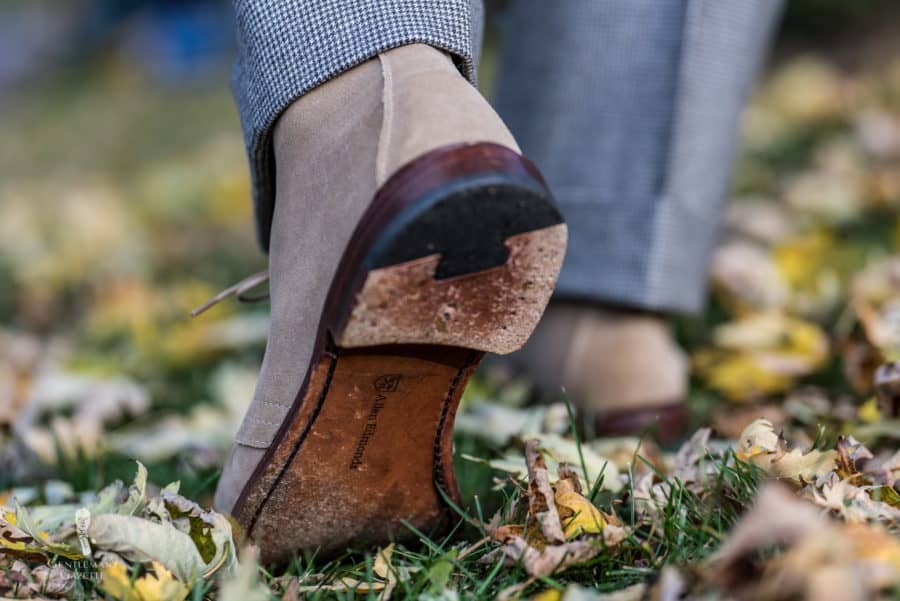
Breaking in the leather sole of a good year welted chukka boot by Allen Edmonds
If you want to go higher than that with finer details, there are lots of brands out there. For example, you get a fiddle back waist and simply more refined overall look. However, that category deserves a guide of its own.
$500 Shoes
Why buy $500 Shoes?
- Comfort. It may take a little longer to break-in the shoe, but they're usually made of all leather which means you sweat less, and they have a cork insole which is soft and cushiony so even if you walk all day, it's still comfortable.
- Leather quality. It is dyed all the way through. It has open pores that are often uncorrected, and you simply get a beautiful leather that develops a patina over time which is exactly what you want because it looks classic and elegant and can be resold. Sometimes, you also get a hand burnished finish from the factory that gets darker towards the toe. The leather lining is usually non-chrome tanned and quite absorbent.
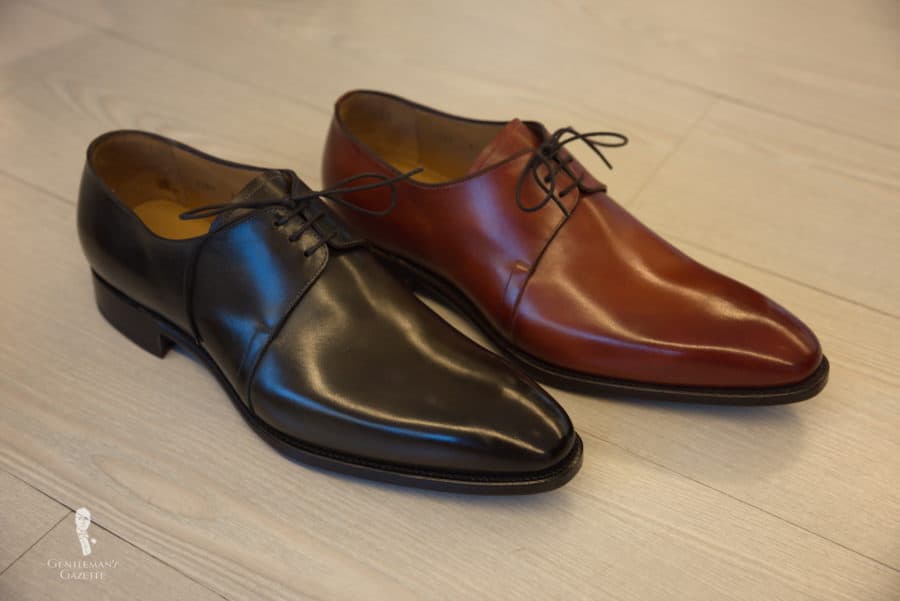
Green and brown shoes with a patina
- Construction. Higher-end shoes undergo a higher end construction method such as a good year welt or a Norvegese welt. $500 shoes are almost exclusively good year welted that means, you have a welt here on the outside, and another welt that connects it in combination with the cork and sole which makes it much more comfortable to wear. For example, this old brogue shoe here has been in my collection since 2003; it's been to five continents, and it's still going strong. In Austria and Hungary, you even have wood pegged shoes which is also a quality traditional method to make shoes.
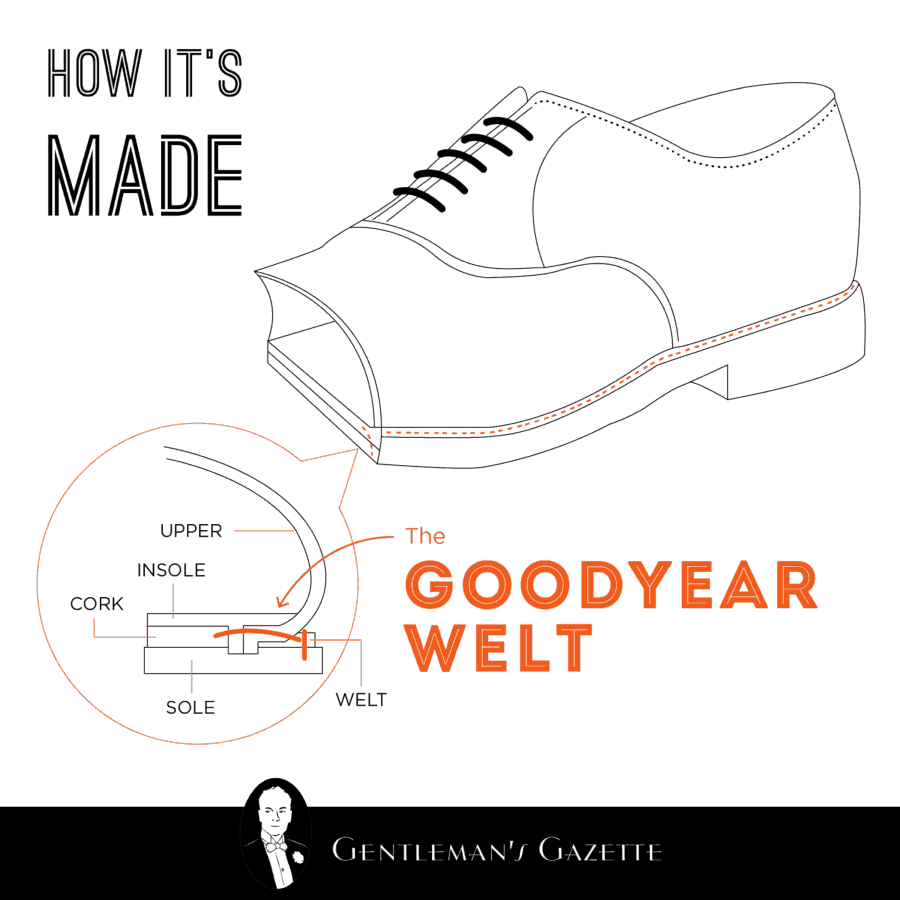
Goodyear Welt Construction
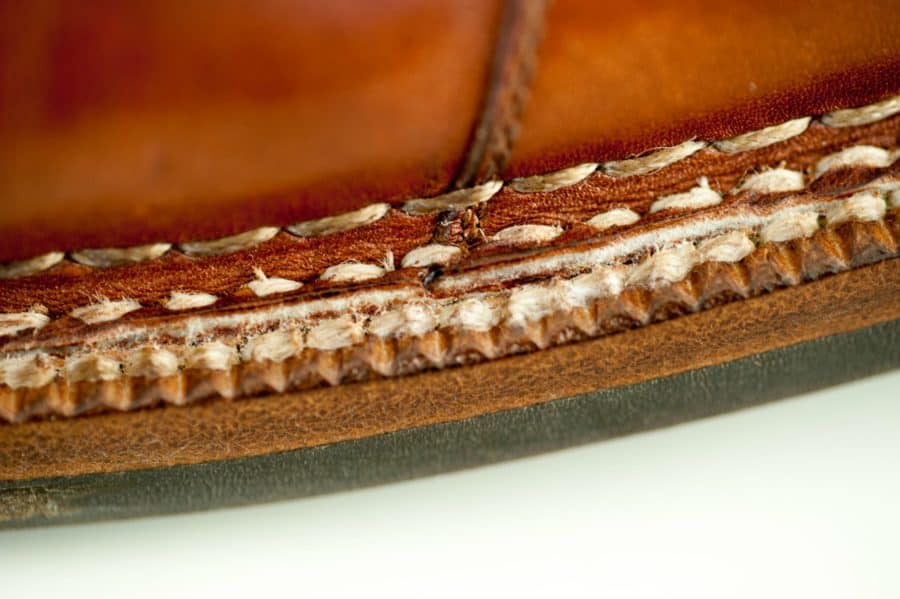
Norvegese – Norwegian Welt
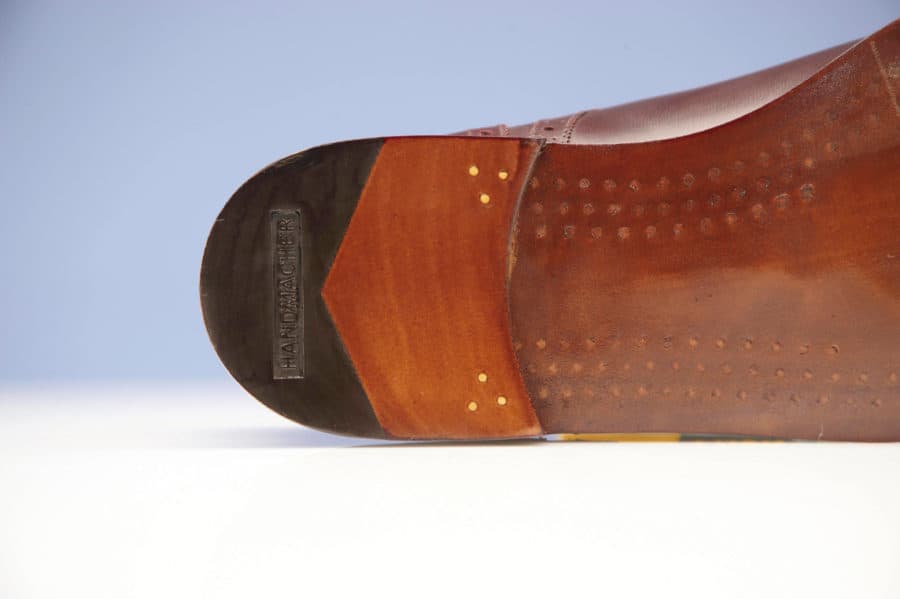
Wood Pegged Austro-Hungarian Men's Dress Shoe
- Heel caps & Toe caps. On a quality shoe, they're usually made of thermoplastic leather. On a very inexpensive shoe, they are usually plastic.
- Lasts. Generally, the lasts on the $500 shoes are just more elegant, refined, and timeless.
- Details. The broguing is nicer; everything is more thought through.
- Colors. Of course, they also have a much larger color range; blues, tans, greens, reds, orange, and anything else you can think of.
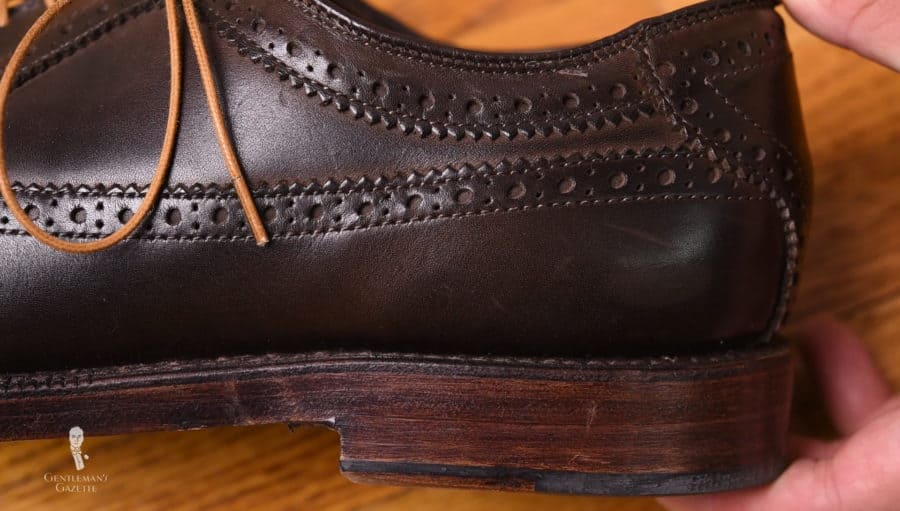
Classic longwing brogue
If you want to learn more about recommended shoe brands, I suggest you go to our shoe guides where we sort them by style; Oxfords, Derbys, boots and much more.
Something to remember: Even if you have the nicest suits, a beautiful tie, a good shirt, and nice cufflinks, cheap shoes will always bring your look down.
George Frazier, a well-respected columnist for Esquire in the 1960's, put it this way:"Wanna know if a guy is well dressed? Look down."
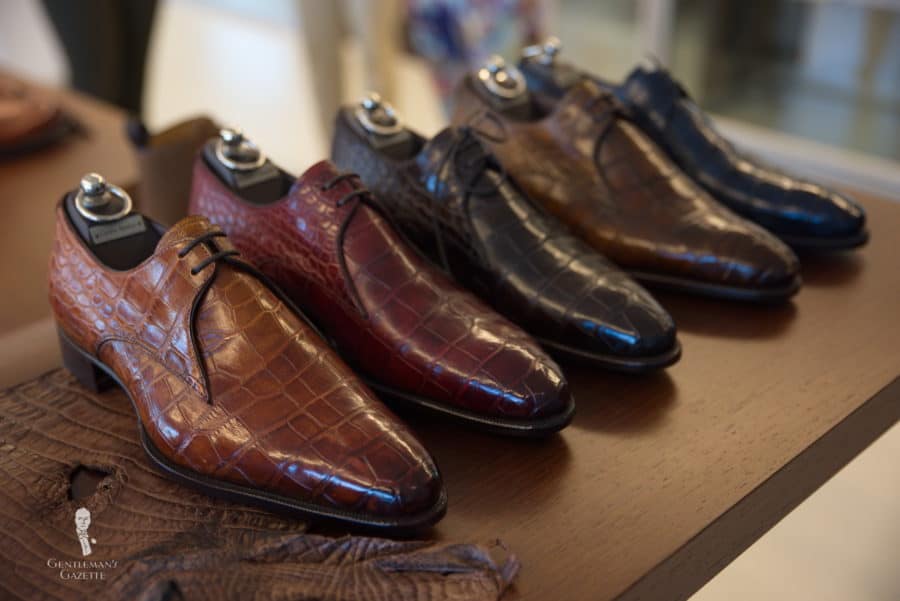
Higher-end shoes
Cost Per Wear
If you want to buy a shoe and you don't think you can justify the high upfront cost, it makes sense to look at the cost per wear. Let's say you have $100 shoe and you can wear it 200 times; that makes it $0.50 per wear. On the other hand, the shoe I bought in 2003 which had a retail price of $500 has probably been used for over 2000 times, that brings the cost down to just $0.25 per wear which is half of the $100 shoe.
Not only does it cost half as much, but I also didn't spend time on replacing my shoe. I had nice shoes throughout the years that looked elegant, upgraded my outfit rather than downgrade it. You also just have only to break it in once, and you can even play with the patina. If it's a lighter color and you want to make it darker, it's no problem because it's open pore leather.
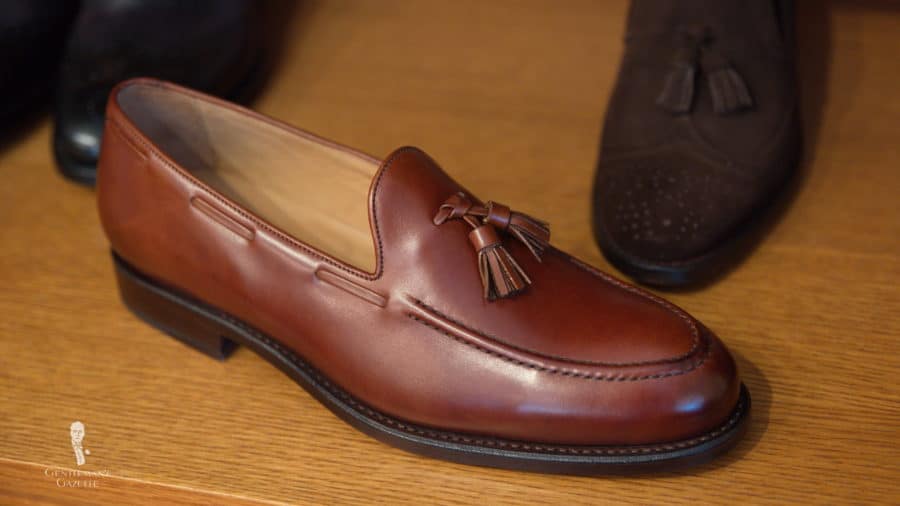
Shoe made out of box calf leather
CONCLUSION
So overall, don't just look at the price but understand what quality you are getting. It's just important that you educate yourself and you know:
- What's the leather like? Is it aniline? Is it pigment dyed?
- What's the sole like?
- What's the construction like?
- What am I paying for here?
What are your tips for shoe buying? Please share in the comments!
600 Dollar Sneacker That Look Like Socks
Source: https://www.gentlemansgazette.com/100-vs-500-usd-dress-shoes-men/
0 Response to "600 Dollar Sneacker That Look Like Socks"
Post a Comment